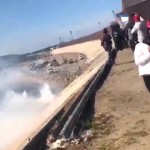Links to today’s show transcripts:
Witness: “No Warning” Before U.S. Border Patrol Started Tear Gassing Central American Asylum Seekers
The Mexican government is demanding a full investigation after U.S. border authorities fired tear gas Sunday into a crowd of Central American asylum seekers as they tried to push their way through the heavily militarized border near San Diego. Among those attacked were mothers and small children, who were left gagging and screaming as tear gas spread. The migrants are mostly from Honduras, Guatemala and El Salvador, and are fleeing widespread violence, poverty and mass unemployment. The Border Patrol’s use of tear gas has been widely condemned. Trump is now urging Mexico to deport the thousands of Central American migrants who are at or approaching the U.S. border in an attempt to seek asylum. Pedro Rios is the director of the American Friends Service Committee’s U.S./Mexico Border Program. He witnessed U.S. border agents using tear gas on Central American migrants on the U.S.-Mexico border on Sunday.
Border Patrol Officer Who Shot Unarmed Teenager on Mexican Soil Is Acquitted of Manslaughter Charges
Last week, a jury found Border Patrol agent Lonnie Swartz not guilty of involuntary manslaughter for shooting and killing 16-year-old José Antonio Elena Rodríguez through the U.S.-Mexico border fence in 2012. The jury hung on whether to bring a charge of voluntary manslaughter, leaving it unclear whether prosecutors would seek to try Swartz a third time. A previous jury acquitted Swartz on murder charges but deadlocked on lesser manslaughter charges. Authorities claim José Elena Rodríguez was throwing rocks at agents over the border fence before Swartz opened fire. But medical examiners say José was shot as many as 11 times, with all but one of the bullets striking from behind, leading them to conclude the teen was shot in the back as he lay on the ground. John Carlos Frey, Emmy Award-winning investigative reporter and PBS NewsHour special correspondent is interviewed. He has reported extensively on the killing of José Antonio Elena Rodríguez.
How a Climate Change-Fueled Drought & U.S.-Fed Violence Are Driving Thousands from Central America
President Trump is urging Mexico to deport the thousands of Central American migrants who are at or approaching the U.S. border in an attempt to seek asylum, days after U.S. border authorities fired tear gas into a crowd of asylum seekers as some tried to push their way through the heavily militarized border near San Diego. Trump tweeted, “Mexico should move the flag waving Migrants, many of whom are stone cold criminals, back to their countries. Do it by plane, do it by bus, do it anyway you want, but they are NOT coming into the U.S.A. We will close the Border permanently if need be. Congress, fund the WALL!” This comes just days before Andrés Manuel López Obrador is sworn in as Mexico’s new president. López Obrador’s incoming government has denied it made any deal with the Trump administration to force asylum seekers to remain in Mexico while their U.S. asylum claims are processed. John Carlos Frey, Emmy Award-winning investigative reporter and PBS NewsHour special correspondent is interviewed. He recently returned from reporting trips in Guatemala, Mexico City and Tijuana, where he was documenting the migrant caravan.
U.S. Prisons Have a Mental Health Crisis. This Story of A New York Prisoner’s Death Helps Reveal Why
U.S. Prisons Have a Mental Health Crisis. This Story of A New York A major new Marshall Project investigation looks at the the mental health crisis in U.S. prisons by diving deep into the story of Karl Taylor, a prisoner who died at a maximum-security prison in the Catskills of New York after an altercation with prison guards in 2015. Karl Taylor was serving out a minimum 27-year sentence for a rape conviction when his life came to a sudden end at the Sullivan Correctional Facility in April of 2015. The African-American prisoner had been diagnosed with delusional disorder and paranoid personality disorder when he was taken into custody in 1995. By April of 2015, Taylor was housed in a special unit at Sullivan for prisoners classified as mentally ill. He had spent nearly ten years in solitary confinement. That’s when he got into what would turn out to be a fatal altercation with a prison guard. Investigative reporter Tom Robbins, author of “Why Is Karl Taylor Dead?” is interviewed.

As we go deeper into this most unusual and challenging phase of history, intelligence is the thing we need the most. That is the theme of the 2019-2020 annual edition of Planet Waves, now available for pre-order. See more information here.

